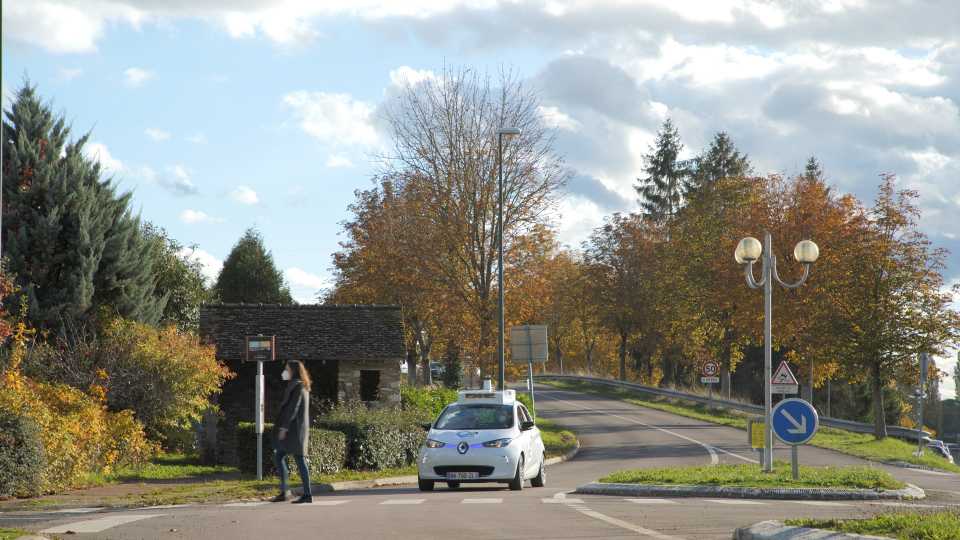Groupe Renault has completed a three-year research project in France which sought to understand the technology required and conditions needed for autonomous vehicles to work away from built-up urban areas. The trial was made up of two key experiments, including one using a specially developed autonomous Renault ZOE.
With large portions of the UK and Europe made up of suburban and rural areas, the findings from this advanced project could be used to help inform how autonomous mobility might work beyond bustling cities in these types of areas that present unique challenges to autonomous vehicles.
The research project consisted of two key trials. The first was an on-demand and shared car service using an autonomous Renault ZOE to provide a direct link between Gazeran train station and Bel Air – La Foret business park in Rambouillet (southwest of Paris). The second was a separate shuttle service calling at predefined stops within the Bel Air business park itself. Both experiments aimed to deliver a reliable, connected autonomous mobility service.
Driving in suburban and rural areas differs dramatically to urban areas. The Tornado project’s technical focus was to define and develop autonomous driving solutions, and communication technologies and infrastructures, that maximise safety and address the specific requirements for suburban and rural areas.
The goal for Groupe Renault was to have an all-electric Renault ZOE drive autonomously over an eight-mile (13km) journey encompassing all of these varying features and challenges. This journey was a route that would be a direct feeder service between Gazeran train station and Bel Air business park.
The project showed that work needs to be done on enhancing the autonomous vehicle’s perception capabilities, enabling it to sense the surroundings within a 360-degree field, including type of object, size and distance from the vehicle, in real time.
Being able to locate and control the autonomous vehicle with 200mm accuracy to ensure it stays on its path, on very narrow roads, regardless of the roadside conditions – for example with or without painted lines or just a verge
Dealing with temporary loss of GPS signal or operating with zero visibility, for example when driving through one-lane tunnels where priority is given to one side or the other
Reaching speeds that are deemed acceptable by everyday drivers and passengers and that match regular traffic speeds.
Over the eight-mile (13km) stretch, tests were conducted on connected infrastructure components such as connected traffic lights and fixed cameras that enable vehicles to see objects beyond their field of perception.
For the autonomous shuttle within the business park itself, users called on the service via the same mobile app as the autonomous Renault ZOE, synced together to provide a continuous, seamless service between the vehicles. Key areas this focused on were advanced perception capabilities, using the connected infrastructure’s capabilities to broaden perception, and ensure the vehicle stayed within its safety perimeters.
For the Tornado project to work, people’s mobility habits in the area – and their views of autonomous vehicles – needed to be understood. Their level of interest in the possibility of future autonomous transport services was also key, and how targeted, safe, shared and environmentally friendly mobility could complement existing setups in areas like Rambouillet.
Connected infrastructure is key in keeping people moving in rural and suburban areas, and it’s something that’s expected to be convenient and appealing by those using it, which is why it was important to involve local authorities. The community – consisting of around 100 people from the area’s MobiLab – were active in various stages of the project.
Numerous sessions of autonomous Renault ZOE trials, and associated workshops, were aimed at studying how autonomous vehicles can be adopted, as well as monitoring the human factors regarding peoples’ feelings towards these ground-breaking new technologies. From these shared experiences and real-life responses, the technical components could be upgraded or adapted as necessary to suit the expectations of the user community.
One of these changes, based on the feedback, was the operating speed of the autonomous ZOEs that were in use. In 2019 it could drive itself up to speeds of 31mph (50km/h), however because users expected the service to more closely match real-life driving and real-life speed limits, they can now drive up to 43mph (70km/h) along certain parts of the route.
Source: https://greenfleet.net
CUT COTS OF THE FLEET WITH OUR AUDIT PROGRAM
The audit is a key tool to know the overall status and provide the analysis, the assessment, the advice, the suggestions and the actions to take in order to cut costs and increase the efficiency and efficacy of the fleet. We propose the following fleet management audit.




